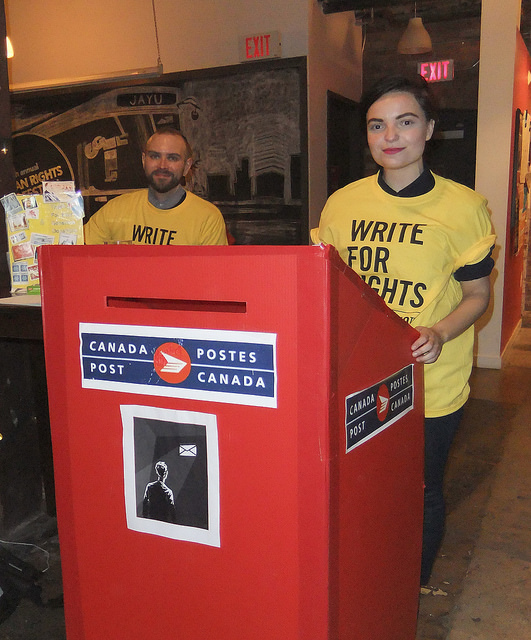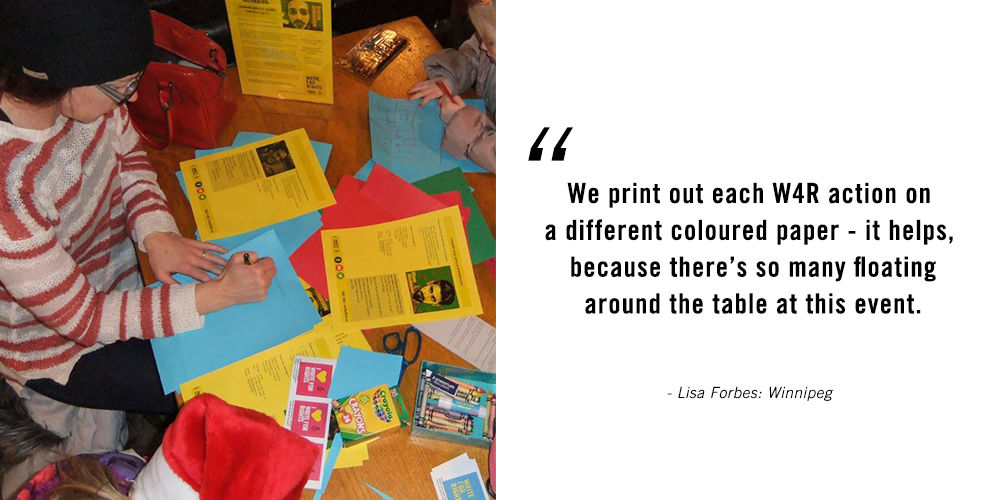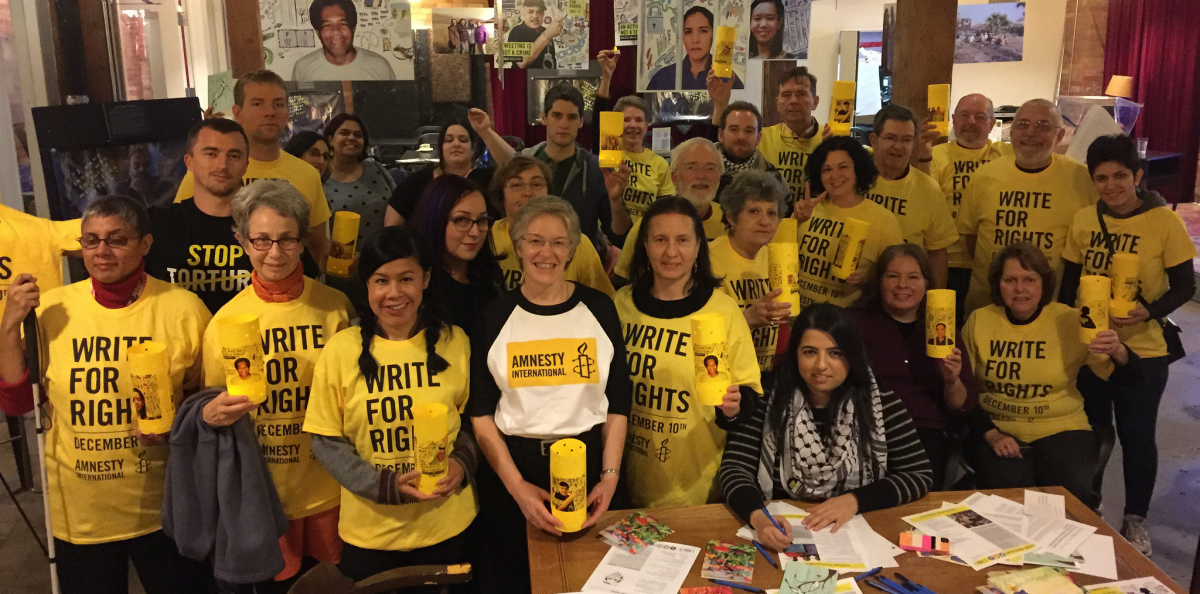
So you’ve signed up to host a Write for Rights event. THANK YOU! Your time and enthusiasm means more people are taking action for human rights on December 10! (Haven’t signed up yet? You can still sign up HERE!)
Planning to write on your own? Register to view our online webinar here >>
We’ve put together a few tips to help you make the most of your event, whether it’s just a few people in your living room or a big event downtown!
1. Spread the word!
If you were selling tickets for your Write for Rights event, how would you publicize in advance? Those strategies will work for building up your presence on the day. Feature a Write for Rights case a day on your blogs or Facebook page. Poster the local libraries and telephone poles with news of the event. Spread the word on social media using our social media shareables.
If you’ve registered your event, you’ll receive an email with a link to your unique event page that you can use to gather RSVPs. You can also use the “Recruit attendees on paper” tool on your event page to gather RSVPs in person. Coming Soon! Use our guide to the events website to learn more.
We’d also love to hear your ideas for getting the word out!
See some examples from local Amnesty organizers of how they spread the word about their Write for Rights events below.
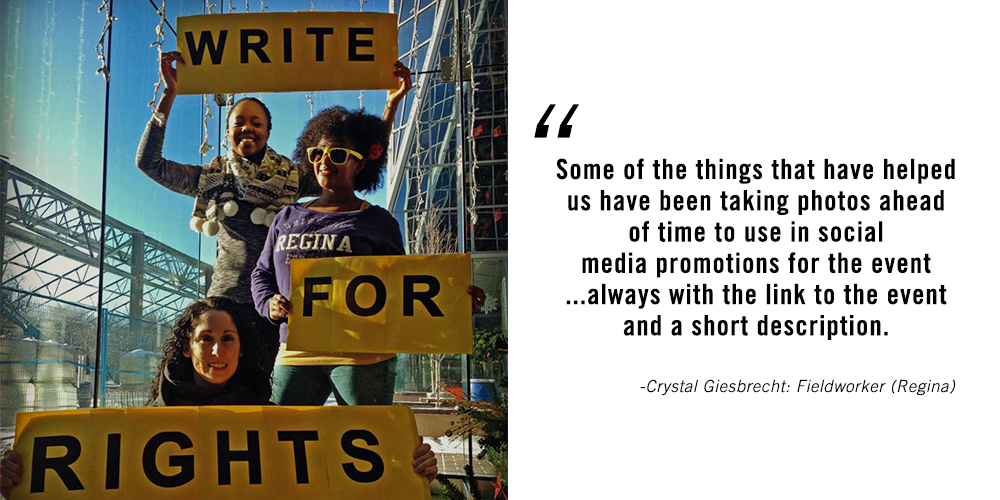
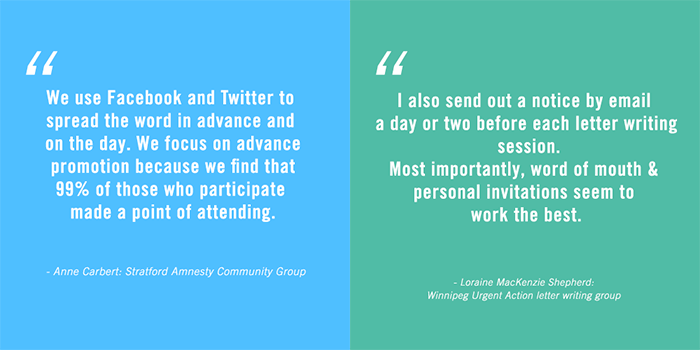
2. Create a Facebook event
Facebook is great for spreading news about an event – BUT FIRST, that event needs to exist in this platform. It’s simple to create a Facebook event, and have all the details of the event available. You can use this to invite friends and family, and encourage them to invite others as well. Plus, during the event and afterwards, people can share their photos easily on the event page!
You can also invite Amnesty Canada to be a co-host of your event to help spread the word.
3. Reach out to local media
Contacting your local paper or television station to share about your event is easy with our Write for Rights Media Guide! Working with your local media is a great way to increase the impact of your event by telling your community about the human rights cases you care about and spurring others to take action. This guide will offer you some quick tips and materials to help you get the attention of your local media!
Some of our local groups have had great success with building relationships with local media – see an example from our Stratford Community group below!
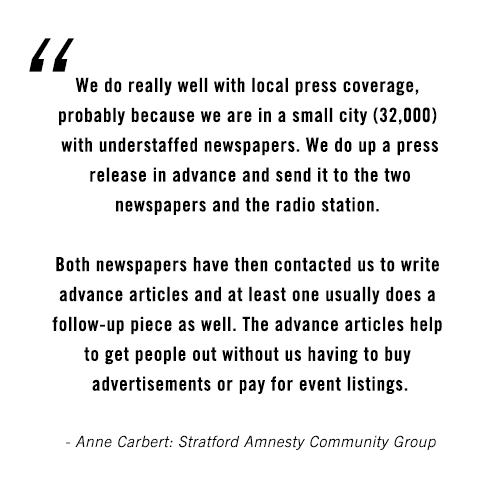
4. Brand the heck outta your event!
“Oh look, it’s Amnesty!” That’s what you want people to say when they see your event. Amnesty’s signature bright yellow colour has immediate recognition. If you have Amnesty t-shirts, be sure to wear them. If you have a pull up poster, bring it along! Props get attention too – so be creative for Write for Rights. Maybe someone has a giant pencil they can lend!?
For more ideas, check out photos from past events!
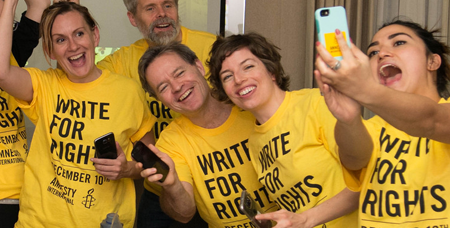
5. Use your space
Take time to consider your space – how can you best set it up? Have some stations for letter writing, and stations for petition signatures. This way, whether a person has 10 minutes or 2 seconds, they can easily support Write for Rights.
When letter-writers arrive at your event, don’t leave them to wander and get lost. Put up posters and direction signs so folks can find you. (bonus tip: make the signs Amnesty yellow!) Have someone near the door to welcome people as they come, and help them get started writing letters.
Make sure it’s obvious where people can leave their letters when they’re done. Consider decorated “mailboxes” – one domestic and one international!
See some examples of creative mailboxes local Amnesty groups have made for Write for Rights events below for inspiration!
(Amnesty group – Regina – mailbox)
(Amnesty group – Toronto – mailbox)
There are many ways you can get creative and use your space to engage new audiences and raise awareness – make sure to share your creative endeavors with us!
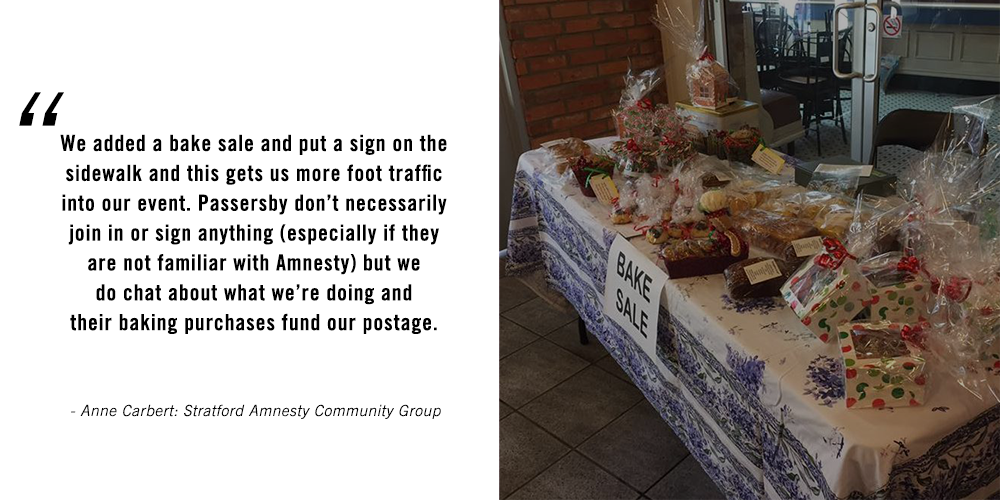
6. Make it easy
Make it easy to write for rights! Have addressed envelopes ready or even use our printable address labels. Make sure there are plenty of Amnesty pens available. Create print-outs of the cases so people can read about who they are supporting. Have letter-writing tips and sample letters available. And finally, get your petitions ready for those who only have time for a quick signature. If possible, set up a few laptops or tablets to allow people to sign online versions of the actions.
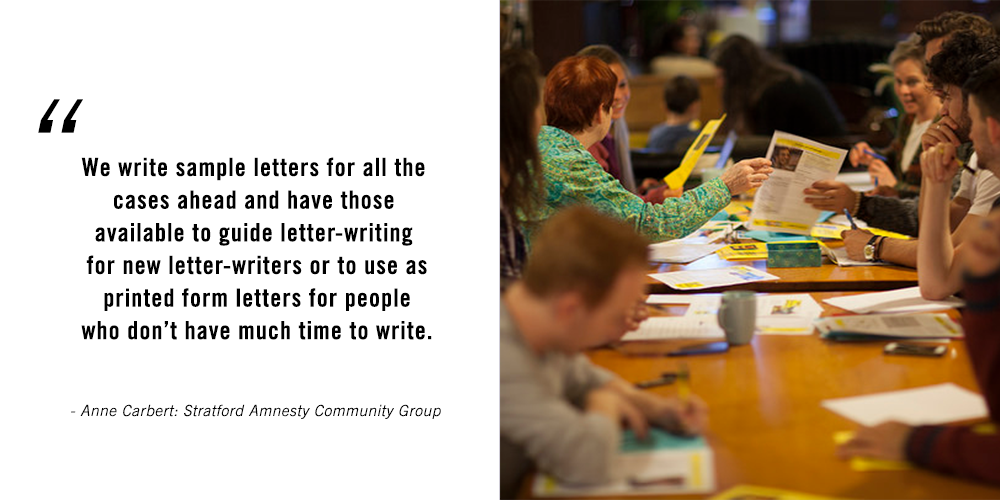
7. Take photos
Photos are essential because they show the power of people taking action for change together. Also, it shows your community how they can get involved. Here are some tips for taking and sharing photos:
- Assign a “photo-taker” – Okay, we’re not all photographers, but we can take photos. Whoever feels most comfortable snapping shots gets the job!
- Have a subject – a picture that is focused on a ‘subject’ (a group of smiling people, a pen, a hand writing, a person holding their letter, etc.) will look good. Whatever you subject make sure it is within the center, or just slightly to the right or left of the center, of the picture.
- Faces are best – take pictures of people smiling and looking at the camera, not just hunched over writing letters. Be sure to get their names, and always ask permission to photograph the individual when you are capturing their face.
- Share your best photos on Instagram, Facebook, or Twitter using the hashtag – Always tag your photos with #Write4Rights and #W4R19
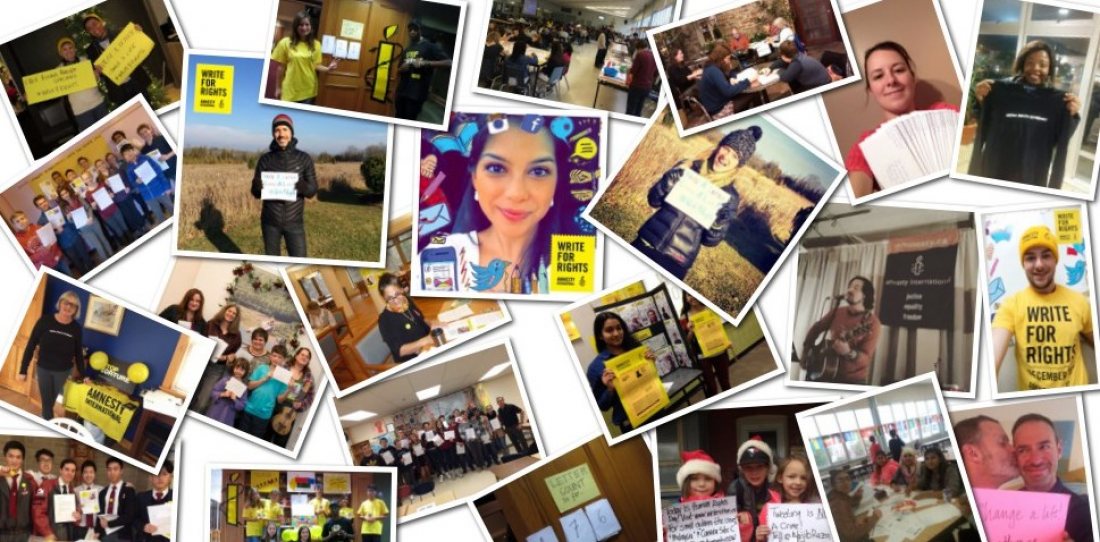
Consider creating a space where participants can show their solidarity with human rights defenders.
You could set up a simple solidarity photobooth or create a selfie photo space with props for people to write their own solidarity messages. You could also bring an old sheet and some markers/ pens/ paint brushes and encourage people to add to a solidarity banner to send to the human rights defenders.
8. Have a kids’ station
This idea won’t work for everyone, but if you can have a place where parents and children can both get involved – go for it! A kids’ station can be simple: paper, pencils and crayons. You could create lanterns from the drawings made and use them to decorate your space (using a simple string and peg approach!). Add a few stickers and you’re on a roll! We have created Case Sheets that are specifically for kids 9+ for the Iran, Nigeria, and Philippines cases.
Most Write for Rights cases also include an option for sending a solidarity message to an individual or community, which is perfect for kids. They can create cards or drawings to send directly to people we’re supporting on Human Rights Day.
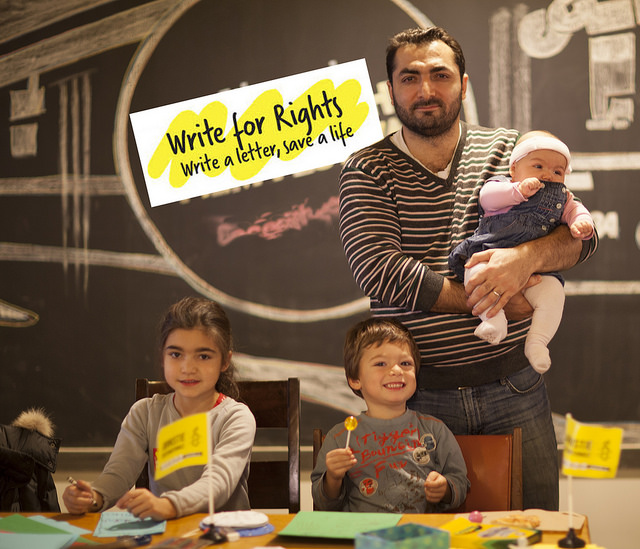
9. Make it fun!
Letter writing is great – but it can be quiet. Can you invite a local musician to play along as people gather to write? Or maybe there’s a great spoken word poet in your area you could invite out? What about your local radio station – maybe they’re interested in coming out for the event? Is your event at a school or university? Ask the debate team along, or the pep squad, or the school band.
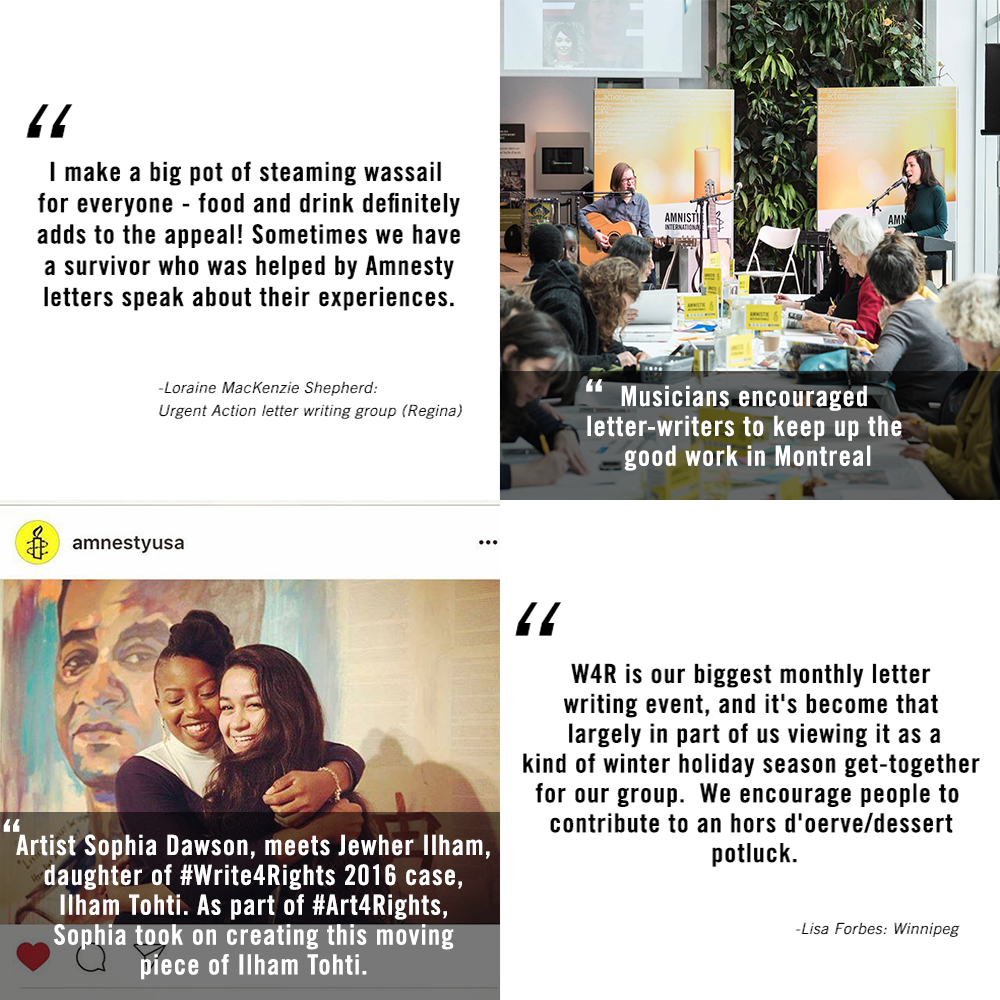
Keep people motivated to write with the Success Stories Slideshow, Write for Rights Videos, and Case Videos in the background. Keep a visible tally of the letters generated at your event as you go!
10. Connect with other events around Canada and the world!
No matter what time your event is at post a message to Twitter, Instagram, or the Facebook Event page. Amnesty activists are taking part during every hour of the day through every time zone around the globe. We’ll be retweeting and sharing your posts to capture the wave of activity as events happen across the world. Be sure to use the hashtags #write4rights and #W4R19.














